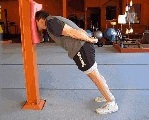What is Neck
The neck is the part of the body, on many terrestrial or secondarily aquatic vertebrates, that distinguishes the head from the torso or trunk. The neck supports the head and keeps it aligned with the body. It is at the top most part of the spine. The spine also runs through the mid and the lower back. The neck is made up of vertebrae, joints, and muscles. The vertebrae are the bones of the spine. They protect the spinal cord inside it and give support for muscles and joints.
Function of the neck:
The main obvious function of the neck is to hold up the head. The neck also contains several blood vessels that allow blood to reach the head and the brain. The neck contains the trachea and part of the esophagus, which allow air and food/water to reach the body, respectively. The neck also contains the upper spinal cord, which controls body movements and is connected to the brain stem in the neck.
Benefits of Neck Exercise:
Exercising your neck can make it stronger, more flexible and reduce neck pain that is caused by stress and fatigue.
Exercising the neck muscles has three benefits:
• It strengthens the muscles of the neck, upper back, and shoulders
• It makes the neck more flexible, increasing its range of motion
• It relaxes the neck and reduces pain
Wall Front Neck Bridge(Body Weight)
Instructions
Preparation:
• Place small or folded cushioned mat on wall or column approximately chest height.
• With hands supporting mat on each side stand back so feet are away from wall or column with body leaning forward.
• Place top of forehead on mat.
• Fold hands behind low back or hips.
Execution:
• Roll down onto forehead until nose touches mat.
• Roll up onto top of head until chin touches upper chest.
• Repeat.
Comments
Keep body somewhat straight bending spine and hips slightly as head rolls down. Waist flexors and extensors as well as hip flexors and knee extenors are used as stabilizers to mantain posture, but are not significant stabilizers. Exercise involves neck flexors as well as neck extensors.
Tips for Neck Exercise:
• Before you start a neck exercise program, talk to your healthcare provider, especially if you have had a neck accident or a history of neck problems.
• Stretch slowly, and avoid sudden movement. Pay attention to your muscles stretching.
• When you have stretched it as far as it can comfortably go, hold for 5 seconds, then slowly return to the original position.
• Breathe slowly and deeply as you exercise. Never stretch to the point where it is no longer comfortable.
• Go to the point where you feel a mild tension, and relax as you hold the stretch. The feeling of tension should go away as you hold the position.
• If it does not ease off slightly and find an amount of tension that is comfortable for you.
• Do 5 repetitions for each exercise unless your healthcare provider has requested a different number of repetitions.











